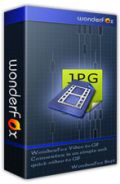Chaque jour, nous vous offrons des logiciels sous licence GRATUITS que vous devriez autrement payer!

Giveaway of the day — WonderFox Video to Picture Converter 1.1
L'offre gratuite du jour pour WonderFox Video to Picture Converter 1.1 était valable le 18 janvier 2014!
WonderFox Video to Picture Converter est une solution simple permettant d'extraire des images par série depuis des cadres vidéo. Grâce à ce programme, vous pouvez enregistrer l'ensemble des cadres d'une vidéo comme une série de photos. En outre, ce programme vous permet de contrôler le nombre d'images par cadre.
Imaginez pouvoir utiliser votre séquence vidéo préférée au format GIF animé dans vos réseaux sociaux et vos loisirs communautaires ! Pour vous garantir que vous obtenez ce que vous recherchez, Video to Picture Converter vous permet de contrôler la cadence de production afin que la qualité soit en phase avec vos critères. Vous pouvez également ajouter des effets spéciaux ou redimensionner chaque image numérique selon vos spécifications exactes, et ce, tout au long du processus !
Fonctionnalités clés :
- Prend en charge l'ensemble des formats vidéo populaires tels que AVI, MP4, MPG, WMV, MKV, MOV, etc. ;
- Prend en charge l'ensemble des formats image populaires tels que JPG, BMP, GIF, TGA, TIF, PNG, PCX, et même les formats ICO ;
- Convertit des vidéos au format GIF animé ;
- Prend en charge l'ajout d'effets spéciaux sur des images ;
- Contrôle la cadence de production afin que la qualité soit en phase avec vos paramètres acceptables ;
- Redimensionnement de l'image de sortie.
Configuration minimale:
Windows NT4/ 2000/ 2003/ XP/ Vista/ 7/ 8; Processor: 1 GHz Intel or AMD CPU; Free Hard Disk Space: 50 MB or more; RAM: 512 MB or above
Éditeur:
WonderFox Soft IncPage web:
http://www.videoconverterfactory.com/video-to-picture-converter/Taille du fichier:
14.6 MB
Prix:
$29.90
Titres en vedette

Vous souhaitez faire une soirée films avec votre famille sans avoir à patienter des heures pour la conversion ? WonderFox DVD Video Converter est votre meilleur choix. Grâce à lui vous pouvez convertir des vidéos, copier des DVD, télécharger des vidéos en ligne et lire des DVD/vidéo, le tout rapidement et sans effort en un seul et même emplacement.

WonderFox HD Video Converter Factory Pro est équipé de la technologie de pointe de conversion vidéo Haute définition (HD). Ce programme permet aux utilisateurs de convertir des vidéos depuis un format de définition standard (SD) en Haute Définition (HD) et de couper la taille de la vidéo à des fins de conversion de vidéos HD au format SD. Ce logiciel de conversion prend en charge plus de 100 formats vidéo.

WonderFox Video Watermark est un logiciel qui se focalise sur la protections de vos droits d'auteur vidéo. Pour protéger votre vidéo de toute utilisation indésirable, il se peut que vous ayez besoin de ce type de programme pour ajouter une identité et des informations de propriété sur vos fichiers vidéo. WonderFox Video Watermark vous permet facilement d'ajouter du texte, une image, un logo, une signature (y compris animée) et tout autre filigrane à votre vidéo. - 50 % DE RÉDUCTION pour les utilisateurs de GOTD (licence à vie/3 PC)Achetez dès maintenant

Si vous partagez vos photos et vos œuvres artistiques, ou si vous souhaitez présenter les produits de votre entreprise sur Internet, l'ajout de filigranes est nécessaire pour les protéger de toute utilisation illégale. WonderFox Photo Watermark vous permet d'ajouter n'importe quel texte ou image à votre filigrane. Cet outil de filigranage offre en outre une interface facile d'utilisation, de sorte que même un novice puisse ajouter simplement des filigranes en seulement quelques clics. - 50 % DE RÉDUCTION pour les utilisateurs de GOTD (licence à vie/3 PC)<Achetez dès maintenant
GIVEAWAY download basket
Commentaires sur WonderFox Video to Picture Converter 1.1
Please add a comment explaining the reason behind your vote.
Installed and registered without problems on a win 8.1 64 Bit system.
Difficult to formulate my impression.
This program takes a video and creates pictures. Serial pictures. The output rate can be chosen between a whatever high rate to 0,5 pictures per second. This is simply lousy bad programming, because you can choose 100 pictures per second from a video with a framerate of 24 fps and if you want to take a picture every 10 second, you cannot use the slider, but you must type in by hand.
My second claim is the program window, which cannot be resized. On my big screen I want to resize windows to the point, where I can really see something...
On a "special effect" (called "special efficay")window on the right site you can manipulate the produced images. The programmer must have misunderstood something. He was happy to include a free picture manipulation library, of course. But why the hell should one "emboss", "blur" or "green" the images?
You can choose to take an image from the video by yourself, but it is missing an automatic scene detection.
I choose a frame to take a picture and detected that the video controls are not standard. The "pause" button does not switch between "pause" and "play". Should in my opinion.
I enlarged the picture and choose between the three different interpolation method. Again : Why the hell should I choose "sawtooth"? The programmer thinks in funny picture manipulation.
I'll try a verdict : easy to use, when you really want to take a picture every second from a video or make an animated gif with pictures, taken every 0,5 seconds. And blur these. Why should I do this?
No real use for me. Uninstalled via reboot.
Thanks GOATD and Wonderfox.
@ #6 - xpman - I believe you are thinking of VirtualDub. It is free at http://virtualdub.sourceforge.net and it does all this plus more.
Well, not all. As you said, picture format output is limited to just a couple image formats, but it's main function is to be a nice little video editor.
It is limited to avi video, but with the zillions of converters offered here, that should not be a huge drawback.
I tried this on Win8 and it's OK. But the only advantage of this over VD is the many formats it handles.
#5: "So I tried it on an HD m2ts file, output as “BEST” – ani gif isn’t that great. Many artifacts.
So I tried .tga frames as they suppose to give best quality … but than I found no good interlaced frames. I can’t find any DE-intelace option .
This is a major drawback of such software"
The problem is the video -- not the software. Most video that you can get your hands on is just not that great when it comes to image quality, but at 24 - 30 fps you don't notice. RE: Interlace & Deinterlace, if the video you have is actually interlaced, you can usually get the best results deinterlacing using various different methods in Avisynth or filters in VirtualDub, though some folks I think have done work in this area using Handbrake -- the idea is you get more total image data shooting interlaced, which you then use Handbrake on to achieve higher quality progressive frames than you could otherwise. That said, if you're going to wind up going back to video once you've processed the frames as still images, you might process the individual fields as 1/2 height stills & reassemble them into interlaced video afterwards. 1 interlaced frame = 2 fields.
* * *
#7: "I believe you are thinking of VirtualDub... It is limited to avi video, but with the zillions of converters offered here, that should not be a huge drawback."
You don't want to convert your video to avi just to disassemble it into individual images -- you'll lose far too much quality. The traditional way you get whatever format of video into VirtualDub is to use Avisynth. After installing Avisynth you write a few lines of scripting in a plain text file you name with an .avs extension -- for something like this there are plenty of examples on-line you can copy/paste. An example would be a single line script:
DirectShowSource("Your Path & Filename Here",The fps For That File Here,video=true)
When you open that .avs file in VirtualDub or whatever program, it will use whatever Direct Show [DS] software you have installed that's available & that can decode that video for playback, say in Windows Media Player. Avisynth will open that file, read the picture data frame by frame, feeding it to VirtualDub as if VirtualDub had opened the video file itself. That skips re-encoding the video & writing it to disk as an avi file, avoiding that quality loss & usually saving quite a bit of time.
If you do decide you need a avi file for whatever reason, Do Not use ffmpeg or anything based on it if at all possible, & that includes the converters that have been on GOTD. Ffmpeg includes and uses Xvid. Xvid is a mp4 video codec that's compatible with old versions of DivX, & was designed to be an alternative to formats like Windows Media [.wmv] for final distribution back before there were better alternatives like AVC. Instead use a [near] lossless format for your avi file(s) -- I use the UT Video codec, but Avid has a nice codec too that's capable of HD that they give away free. What I use, FWIW, is Avisynth -> VirtualDub, having V/Dub write a avi file using UT Video.
A number of years ago I had a freeware program (unfortunately forgot its name) that would extract images from video, if memory serves me correctly it would only do it for one type.
Having said that it was very flexible in the way it extracted video, for example every so many frames, a number of equally spaced frames.
I anticipated today's program would work in a similar fashion and that it would do much more for such a high price.
It has none of the above useful features but, as #3 Karl correctly points out, a number of useless features.
I hope someone will offer something similar that is worth having, today's offering is far too limited to be of much use and way overpriced!
Installed fine on XPSP3,
So I tried it on an HD m2ts file, output as "BEST" - ani gif isn't that great. Many artifacts.
So I tried .tga frames as they suppose to give best quality ... but than I found no good interlaced frames. I can't find any DE-intelace option .
This is a major drawback of such software


les pollueurs sont de retour
Save | Cancel
http://tr.im/4rhqn
Save | Cancel
Why I Don’t Like Working From Home http://www.whitec0de.com/dont-like-working-home/
Save | Cancel
http://my.jetscreenshot.com/16200/20140118-bv5a-4591kb.jpg
Save | Cancel
Merci GOTD, j'ai trouvé un grand don de logiciel d'intimité http://goo.gl/Yljgq4
Save | Cancel